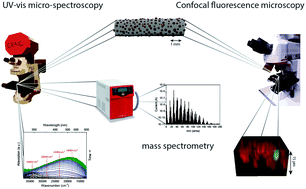The influence of the binder material in an industrial-type catalyst material is often neglected, although the addition of a binder can cause a significant change in the performance of the catalyst. It is difficult to visualize the effects of the different components in these multi-complex materials, and therefore, high spatiotemporal resolution techniques need to be employed. In this work, two complementary micro-spectroscopic techniques; operando UV-vis diffuse reflectance micro-spectroscopy (coupled to on-line mass spectrometry), and in situ confocal fluorescence microscopy were used to investigate the 1-hexene oligomerization reaction. The reaction was performed on both Al2O3- and SiO2-bound ZSM-5-containing extrudates at 250 °C and 300 °C. By employing operando UV-vis micro-spectroscopy, coupled with on-line mass spectrometry, Al2O3-bound catalysts were found to form larger reaction products, as well as more and larger hydrocarbon deposits, compared to the SiO2-bound catalysts. Furthermore, the extrudate containing Al2O3 deactivated slower than the extrudate containing SiO2 binder. Time-resolved chemical maps of the location of the reaction products were visualized using in situ confocal fluorescence microscopy. The maps show that, after reaction, the zeolite crystals contain different coke species than the Al2O3 binder.

